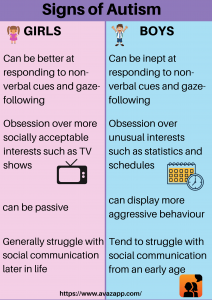

Careful assessment of developmental history is prescribed also in several other diagnostic guidelines.
#Add vs autism full#
The guidelines further state that the diagnostic assessment should include a full evaluation of developmental history. Īccording to the evidence-based recommendations for health care in England, practitioners assessing ADHD and ASD in children and adolescents should carefully evaluate the core symptoms of the disorders. Concerns have been raised about possible overdiagnosis and with risks of underappreciating other difficulties that may be more relevant to general functioning and health, such as intellectual functioning and learning disabilities. However, increases in prevalence, less temporal stability than once assumed, and a possible group of children onsetting with symptoms first during puberty have generated discussions about the validity of the ADHD and ASD diagnoses. Early detection rests on the notion that the disorders reflect temporally stable differences in core functioning. Įarly detection and diagnosis of ADHD and ASD have been highlighted as important so that affected individuals and their families can access proper information and support. Causes of ADHD and ASD are unknown, but evidence suggests that their etiologies are heterogeneous, largely genetic, and that many genes with small effects are involved. Incidence of the disorders has increased during the last decades which appears to be the result of changes in service access, diagnostic practices, and more perceived impairment rather than true prevalence increases. About one in eight children with ADHD also meet diagnostic criteria for ASD and 40–70% of youth with ASD experience clinically significant ADHD symptoms.

ASD is characterized by enduring and impairing difficulties in social communication/interaction and restrictive and repetitive behaviors, interests, and activities, or sensory abnormalities and affects 1–4% of children and adolescents. ADHD is characterized by difficulties with inattention and/or hyperactivity and impulsivity and is prevalent in children and adolescents, affecting 5–15%, with differences in prevalence rates mostly stemming from methodological characteristics of included studies.

Etiological heterogeneity and considerable temporal fluctuation in the core characteristics of ADHD and ASD may explain the lack of distinct developmental patterns.Īttention-deficit/hyperactivity disorder (ADHD) and autism spectrum disorder (ASD) are common neurodevelopmental disorders with an early onset. Developmental deviations are part of normal development and common in children without ADHD and ASD. Developmental information alone cannot be used to accurately predict diagnostic status in adolescence and false positives are likely if the diagnostic process relies heavily on such information. ADHD and ASD are characterized by broad and non-specific developmental deviations. The mean proportion of developmental deviations was 18.7% in the ADHD group, 20.0% in the ASD group, and 15.6% in peers youth with both ADHD and ASD ( n = 50) deviated on 21.8% of all developmental signs and had more pronounced deviations than those with ADHD or ASD alone. Predictive models correctly identified 66% of individuals with ADHD and 81% of those with ASD, but 62–88% of identified cases were false positives. Adolescents with ADHD ( n = 627) and ASD ( n = 91) differed from their peers on a plethora of developmental signs, with signs closely related to the core symptoms of the disorders after age 5 being most indicative of the disorders.

Accuracy of the most indicative information to predict ADHD and ASD diagnoses in adolescence was evaluated. Fifteen-thousand variables were screened, and 506 variables included in the final analyses. In this study, physical, family, psychological, social, and educational information were examined in 3623 ethnically diverse children that were prospectively followed from birth to age 15 as part of the Fragile Families and Child Wellbeing Study. Guidelines recommend a careful evaluation of developmental history when assessing the disorders, but it is unclear how children with ADHD and ASD differ from their peers growing up. Attention-deficit/hyperactivity disorder (ADHD) and autism spectrum disorder (ASD) are neurodevelopmental disorders with an early onset.


 0 kommentar(er)
0 kommentar(er)
